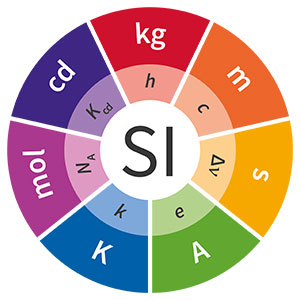 In a landmark decision, made at the 26th meeting of the General Conference on Weights and Measures (CGPM), the Member States of the Metre Convention voted to revise the International System of Units (SI). This means that the base units are now defined in terms of constants that describe the natural world, which are the most stable references available for us to use.
In a landmark decision, made at the 26th meeting of the General Conference on Weights and Measures (CGPM), the Member States of the Metre Convention voted to revise the International System of Units (SI). This means that the base units are now defined in terms of constants that describe the natural world, which are the most stable references available for us to use.
From 20 May 2019 four of the base units acquired new definitions: the kilogram, ampere, kelvin and mole. The definitions of the other three base units were reworded to emphasise their dependence on their corresponding defining constants. The most substantial change was how the kilogram is defined. The kilogram is now defined in terms of the Planck constant rather than as the mass of the International Prototype of the Kilogram held at the BIPM in France.
More accurate measurement facilitates advances in science and technology, which in turn allows more accurate measurement. But this ever-improving accuracy needs to be enabled by stable measurement standards underpinned by agreed definitions of measurement units.
Continuously improving the definitions of the units ultimately makes it possible to have tighter tolerances, better efficiency and less waste. For example, gears will fit together better and therefore function more efficiently and manufacturing will be able to rely on the dimensions of parts to fit together.
The kilogram was the last SI base unit to be defined in terms of an artefact: the International Prototype of the Kilogram (IPK). By definition, prior to 20 May 2019, the IPK always weighed one kilogram exactly. However, studies of closely similar copies told us that the mass of the IPK was almost certainly changing… minutely. This implied a tiny but unknown change in the values of all masses. For the kilogram, and for all units, we needed to rule out this type of problem, caused by relying on physical artefacts as standards.
Constants of nature, such as the speed of light, are unchanging over time and space. Because of this, these constants provide the most stable and exact way to define SI base units into the future. If we can assign them exact numerical values (based on our best measurements at the time) this in turn defines the units which we use to express these constants.
The revision to the SI was a profound change in approach, underpinning all measurements used in science and more widely. But in everyday life, not much has changed. The new units are the same size as previously but are now defined more precisely. The changes ensure that the SI definitions will remain robust into the future, ready to accommodate future advances in science and technology, which will be able to be translated directly into improvements in the accuracy of measurement.
The new definitions impacted four of the base units:
The Last Artifact from MontanaPBS is a 90 minute film that follows the story of the kilogram redefinition. It features scientists from NPL and across the world who worked on the metrology that enabled this profound change to happen.
The new definitions provide the foundation for improved measurement for decades to come. Whilst the changes impact a small number of high-level electrical calibration services, most of our customers using NPL's calibration services can expect a negligible impact.
Information for users about the revised SI
Information for users of NPL calibration services for electrical quantities